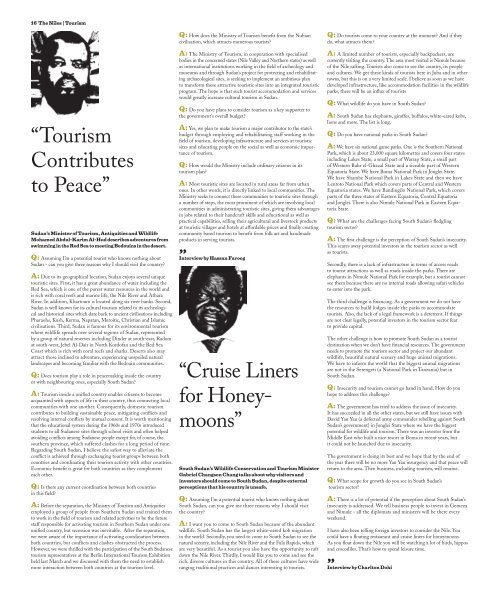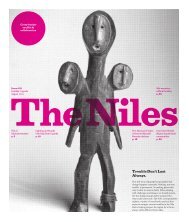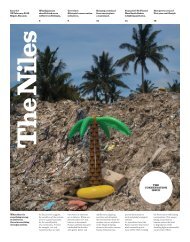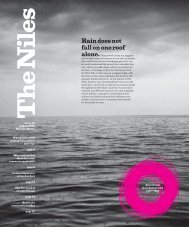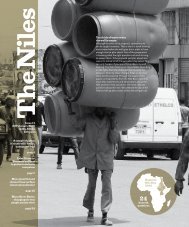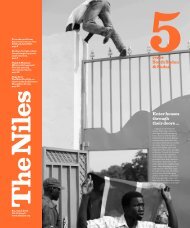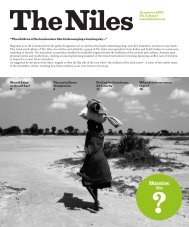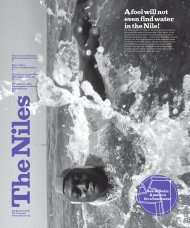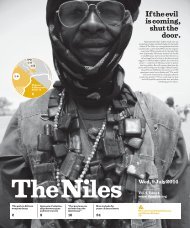Those who have no fence around their land...
...have no enemies. Land has always been more than a matter of square meters for the Sudanese and South Sudanese. The multitude of local languages spoken in the two countries include a vast array of words for land. The precise meaning of the word varies from language to language – but the core remains the same: Land is a cherished asset. This has long been recognised by international investors who lease or buy land in South Sudan and Sudan. Meanwhile the two Sudans argue over minerals and borders. But is the answer fewer fences – as the East African idiom suggests? The Niles journalists, who hail from across both countries, have tackled this highly sensitive topic and have no easy answers. But they have at least sown the seeds of fresh ideas in the third edition of The Niles. Hopefully, they will land on fertile ground.
...have no enemies. Land has always been more than a matter of square meters for the Sudanese and South Sudanese. The multitude of local languages spoken in the two countries include a vast array of words for land. The precise meaning of the word varies from language to language – but the core remains the same: Land is a cherished asset. This has long been recognised by international investors who lease or buy land in South Sudan and Sudan. Meanwhile the two Sudans argue over minerals and borders. But is the answer fewer fences – as the East African idiom suggests? The Niles journalists, who hail from across both countries, have tackled this highly sensitive topic and have no easy answers. But they have at least sown the seeds of fresh ideas in the third edition of The Niles. Hopefully, they will land on fertile ground.
You also want an ePaper? Increase the reach of your titles
YUMPU automatically turns print PDFs into web optimized ePapers that Google loves.
2<br />
16 The Niles | Tourism<br />
Brainteaser | The Niles 17<br />
“Tourism<br />
Contributes<br />
to Peace”<br />
Sudan’s Minister of Tourism, Antiquities and Wildlife<br />
Mohamed Abdul-Karim Al-Hud describes adventures from<br />
swimming in the Red Sea to meeting Bedouins in the desert.<br />
Q: Assuming I’m a potential tourist <strong>who</strong> k<strong>no</strong>ws <strong>no</strong>thing about<br />
Sudan - can you give three reasons why I should visit the country?<br />
A: Due to its geographical location, Sudan enjoys several unique<br />
touristic sites. First, it has a great abundance of water including the<br />
Red Sea, which is one of the purest water resources in the world and<br />
is rich with coral reefs and marine life, the Nile River and Atbara<br />
River. In addition, Khartoum is located along six river banks. Second,<br />
Sudan is well k<strong>no</strong>wn for its cultural tourism related to its archeological<br />
and historical sites which date back to ancient civilisations including<br />
Pharaohs, Kush, Kerma, Napatan, Meroitic, Christian and Islamic<br />
civilisations. Third, Sudan is famous for its environmental tourism<br />
where wildlife spreads over several regions of Sudan, represented<br />
by a group of natural reserves including Dinder at south-east, Radom<br />
at south-west, Jebel Al-Dair in North Kordofan and the Red Sea<br />
Coast which is rich with coral reefs and sharks. Deserts also may<br />
attract those inclined to adventure, experiencing unspoiled natural<br />
<strong>land</strong>scapes and becoming familiar with the Bedouin communities.<br />
Q: Does tourism play a role in peacemaking inside the country<br />
or with neighbouring ones, especially South Sudan?<br />
A: Tourism inside a unified country enables citizens to become<br />
acquainted with aspects of life in <strong>their</strong> country, thus connecting local<br />
communities with one a<strong>no</strong>ther. Consequently, domestic tourism<br />
contributes to building sustainable peace, mitigating conflicts and<br />
resolving internal conflicts by mutual consent. It is worth mentioning<br />
that the educational system during the 1960s and 1970s introduced<br />
students to all Sudanese sites through school visits and often helped<br />
avoiding conflicts among Sudanese people except for, of course, the<br />
southern province, which suffered clashes for a long period of time.<br />
Regarding South Sudan, I believe the safest way to alleviate the<br />
conflict is achieved through exchanging tourist groups between both<br />
countries and coordinating <strong>their</strong> tourism activity with other countries.<br />
Eco<strong>no</strong>mic benefit is great for both countries as they complement<br />
each other.<br />
Q: Is there any current coordination between both countries<br />
in this field?<br />
A: Before the separation, the Ministry of Tourism and Antiquities<br />
employed a group of people from Southern Sudan and trained them<br />
to work in the field of tourism and related activities to be the future<br />
staff responsible for activating tourism in Southern Sudan under one<br />
unified country, but secession was inevitable. After the separation,<br />
we were aware of the importance of activating coordination between<br />
both countries, but conflicts and clashes obstructed the process.<br />
However, we were thrilled with the participation of the South Sudanese<br />
tourism representatives at the Berlin International Tourism Exhibition<br />
held last March and we discussed with them the need to establish<br />
more interaction between both countries at the tourism level.<br />
Q: How does the Ministry of Tourism benefit from the Nubian<br />
civilisation, which attracts numerous tourists?<br />
A: The Ministry of Tourism, in cooperation with specialised<br />
bodies in the concerned states (Nile Valley and Northern states) as well<br />
as international institutions working in the field of archeology and<br />
museums and through Sudan’s project for protecting and rehabilitating<br />
archaeological sites, is seeking to implement an ambitious plan<br />
to transform these attractive touristic sites into an integrated touristic<br />
program. The hope is that such tourist accommodation and services<br />
would greatly increase cultural tourism in Sudan.<br />
Q: Do you <strong>have</strong> plans to consider tourism as a key supporter to<br />
the government’s overall budget?<br />
A: Yes, we plan to make tourism a major contributor to the state’s<br />
budget through employing and rehabilitating staff working in the<br />
field of tourism, developing infrastructure and services at touristic<br />
sites and educating people on the social as well as eco<strong>no</strong>mic importance<br />
of tourism.<br />
Q: How would the Ministry include ordinary citizens in its<br />
tourism plan?<br />
A: Most touristic sites are located in rural areas far from urban<br />
ones. In other words, it is directly linked to local communities. The<br />
Ministry seeks to connect these communities to touristic sites through<br />
a number of steps, the most prominent of which are involving local<br />
communities in administrating touristic sites, giving them advantages<br />
in jobs related to <strong>their</strong> handcraft skills and educational as well as<br />
practical capabilities, selling <strong>their</strong> agricultural and livestock products<br />
at touristic villages and hotels at affordable prices and finally creating<br />
community based tourism to benefit from folk art and handmade<br />
products in serving tourists.<br />
”Interview by Hassan Faroog<br />
“Cruise Liners<br />
for Honeymoons”<br />
South Sudan’s Wildlife Conservation and Tourism Minister<br />
Gabriel Changson Chang talks about why visitors and<br />
investors should come to South Sudan, despite external<br />
perceptions that his country is unsafe.<br />
Q: Assuming I’m a potential tourist <strong>who</strong> k<strong>no</strong>ws <strong>no</strong>thing about<br />
South Sudan, can you give me three reasons why I should visit<br />
the country?<br />
A: I want you to come to South Sudan because of the abundant<br />
wildlife. South Sudan has the largest white-eared kob migration<br />
in the world. Secondly, you need to come to South Sudan to see the<br />
natural scenery, including the Nile River and the Fula Rapids, which<br />
are very beautiful. As a tourist you also <strong>have</strong> the opportunity to raft<br />
down the Nile River. Thirdly, I would like you to come and see the<br />
rich, diverse cultures in this country. All of these cultures <strong>have</strong> wide<br />
ranging traditional practices and dances interesting to tourists.<br />
Q: Do tourists come to your country at the moment? And if they<br />
do, what attracts them?<br />
A: A limited number of tourists, especially backpackers, are<br />
currently visiting the country. The area most visited is Nimule because<br />
of the Nile rafting. Tourists also come to see the country, its people<br />
and cultures. We get these kinds of tourists here in Juba and in other<br />
towns, but this is on a very limited scale. I believe as soon as we <strong>have</strong><br />
developed infrastructure, like accommodation facilities in the wildlife<br />
parks, there will be an influx of tourists<br />
Q: What wildlife do you <strong>have</strong> in South Sudan?<br />
A: South Sudan has elephants, giraffes, buffalos, white-eared kobs,<br />
lions and more. The list is long.<br />
Q: Do you <strong>have</strong> national parks in South Sudan?<br />
A: We <strong>have</strong> six national game parks. One is the Southern National<br />
Park, which is about 23,000 square kilometres and covers four states<br />
including Lakes State, a small part of Warrap State, a small part<br />
of Western Bahr el-Ghazal State and a sizeable part of Western<br />
Equatoria State. We <strong>have</strong> Boma National Park in Jonglei State.<br />
We <strong>have</strong> Shambe National Park in Lakes State and then we <strong>have</strong><br />
Lentoto National Park which covers parts of Central and Western<br />
Equatoria states. We <strong>have</strong> Bandingilo National Park, which covers<br />
parts of the three states of Eastern Equatoria, Central Equatoria<br />
and Jonglei. There is also Nimule National Park in Eastern Equatoria<br />
State.<br />
Q: What are the challenges facing South Sudan’s fledgling<br />
tourism sector?<br />
A: The first challenge is the perception of South Sudan’s insecurity.<br />
This scares away potential investors in the tourism sector as well<br />
as tourists.<br />
Secondly, there is a lack of infrastructure in terms of access roads<br />
to tourist attractions as well as roads inside the parks. There are<br />
elephants in Nimule National Park for example, but a tourist can<strong>no</strong>t<br />
see them because there are <strong>no</strong> internal roads allowing safari vehicles<br />
to enter into the park.<br />
The third challenge is financing. As a government we do <strong>no</strong>t <strong>have</strong><br />
the resources to build lodges inside the parks to accommodate<br />
tourists. Also, the lack of a legal framework is a deterrent. If things<br />
are <strong>no</strong>t clear legally, potential investors in the tourism sector fear<br />
to provide capital.<br />
The other challenge is how to promote South Sudan as a tourist<br />
destination when we don’t <strong>have</strong> financial resources. The government<br />
needs to promote the tourism sector and project our abundant<br />
wildlife, beautiful natural scenery and huge animal migrations.<br />
We <strong>have</strong> to inform the world that the biggest animal migrations<br />
are <strong>no</strong>t in the Serengeti (a National Park in Tanzania) but in<br />
South Sudan.<br />
Q: Insecurity and tourism can<strong>no</strong>t go hand in hand. How do you<br />
hope to address this challenge?<br />
A: The government has tried to address the issue of insecurity.<br />
It has succeeded in all the other states, but we still <strong>have</strong> issues with<br />
David Yau Yau (a defected army commander rebelling against South<br />
Sudan’s government) in Jonglei State where we <strong>have</strong> the biggest<br />
potential for wildlife and tourism. There was an investor from the<br />
Middle East <strong>who</strong> built a nice resort in Boma in recent years, but<br />
it could <strong>no</strong>t be launched due to insecurity.<br />
The government is doing its best and we hope that by the end of<br />
the year there will be <strong>no</strong> more Yau Yau insurgency and that peace will<br />
return to the area. Then business, including tourism, will resume.<br />
Q: What scope for growth do you see in South Sudan’s<br />
tourism sector?<br />
A: There is a lot of potential if the perception about South Sudan’s<br />
insecurity is addressed. We tell business people to invest in Gemeza<br />
and Nimule - all the diplomats and ministers will be there every<br />
weekend.<br />
I <strong>have</strong> also been telling foreign investors to consider the Nile. You<br />
could <strong>have</strong> a floating restaurant and cruise liners for honeymoons.<br />
As you float down the Nile you will be watching a lot of birds, hippos<br />
and crocodiles. That’s how to spend leisure time.<br />
”Interview by Charlton Doki<br />
Five top tips<br />
for visitors<br />
to Sudan<br />
1/Bajraweya or Meroe<br />
Pyramids<br />
Located only three hours<br />
from Sudan’s capital, the Meroe<br />
Pyramids formed the focus<br />
of Sudan’s Kush kingdom for<br />
several centuries. They are<br />
also k<strong>no</strong>wn as Bajreweya after<br />
a nearby village. Nestled in<br />
a desert, the majestic pyramids<br />
are a top tourist location.<br />
2/Omdurman Market<br />
This bustling market is a ‘must see’<br />
for any visitors seeking local crafts,<br />
traditional jewelry and Sudanese<br />
delicacies.<br />
3/Whirling Dervishes<br />
At <strong>around</strong> an hour before sunset<br />
every Friday, head to Hamad<br />
Al-Neel in Omdurman to witness<br />
dervishes performing Sufi ritual<br />
dances and drumming.<br />
4/Suakin Is<strong>land</strong><br />
& the Red Sea<br />
Port Sudan, just a few hours<br />
away from the capital, is re<strong>no</strong>wned<br />
for its excellent diving sites, its<br />
virgin coral reefs and beautiful<br />
beaches. Some 60 kilometers from<br />
Port Sudan lies Suakin Is<strong>land</strong>.<br />
Once a trading port for pharaohs,<br />
it is <strong>no</strong>w an ancient site, well<br />
worth a visit. But beware of the<br />
local cats, which are rumoured<br />
to be haunted.<br />
5/The confluence of<br />
the White and Blue Niles<br />
The While Nile comes from Lake<br />
Victoria in Uganda and the Blue<br />
Nile flows from Ethiopia. They<br />
meet in Khartoum, Sudan’s capital,<br />
to form what is called “the longest<br />
kiss in history”.<br />
Five top tips<br />
for visitors to<br />
South Sudan<br />
1/Mount Kinyeti<br />
Located in Eastern Equatoria<br />
State, this impressive mountain<br />
is the highest in the country and<br />
offers tourists a magnificent view.<br />
2/Kagelu teak forest<br />
in Yei County<br />
This beautiful forest in Central<br />
Equatoria State is the perfect backdrop<br />
for hikers and nature fans.<br />
3/Bandingilo National Park<br />
Not far from the capital Juba, the<br />
Bandingilo National Park offers<br />
attractive scenery – and it is safe.<br />
4/Terekeka<br />
Not far from Juba, Terekeka is<br />
rumored to serve the best fish in<br />
South Sudan. Alternatively, you<br />
could try crocodile which is served<br />
as a delicacy.<br />
5/Kajo Keji<br />
Reputedly here you can sample<br />
the best local bush rat in South<br />
Sudan.<br />
224<br />
217<br />
238<br />
223<br />
216<br />
227<br />
225<br />
218<br />
210<br />
211<br />
209<br />
126<br />
222<br />
219<br />
242<br />
237<br />
239<br />
236<br />
240<br />
234<br />
226<br />
215<br />
134<br />
127<br />
125<br />
connect<br />
the<br />
235<br />
228<br />
233<br />
241<br />
243<br />
221<br />
245<br />
232<br />
124<br />
128<br />
119<br />
246<br />
244<br />
116<br />
291<br />
138<br />
267<br />
231<br />
229<br />
220<br />
212<br />
214<br />
133<br />
118<br />
135<br />
120<br />
113<br />
247<br />
269<br />
230<br />
213<br />
139<br />
137<br />
132<br />
117<br />
248<br />
208<br />
123<br />
121<br />
143<br />
112<br />
136<br />
290<br />
253<br />
122<br />
115<br />
114<br />
292<br />
249<br />
294<br />
140<br />
131<br />
142<br />
129<br />
300<br />
268<br />
266<br />
144<br />
141<br />
111<br />
293<br />
270<br />
289<br />
254<br />
252<br />
250<br />
145<br />
110<br />
105<br />
295<br />
151<br />
106<br />
101<br />
301<br />
271<br />
100<br />
104<br />
95<br />
96<br />
299<br />
130<br />
99<br />
258<br />
102<br />
150<br />
94<br />
97<br />
98<br />
298<br />
296<br />
288<br />
103<br />
dots<br />
257<br />
152<br />
107<br />
146<br />
109<br />
92<br />
297<br />
274<br />
93<br />
259<br />
91<br />
287<br />
279<br />
302<br />
256<br />
251<br />
85<br />
307<br />
306<br />
149<br />
308<br />
153 154 155<br />
275<br />
309<br />
273<br />
260<br />
255<br />
77<br />
305<br />
156<br />
310<br />
304<br />
207<br />
280<br />
276<br />
162<br />
108<br />
278<br />
261<br />
272<br />
147<br />
311<br />
86<br />
82<br />
80<br />
78 79<br />
75<br />
76<br />
303<br />
286<br />
277<br />
161<br />
90<br />
148<br />
312<br />
265<br />
163<br />
73 74<br />
83<br />
81<br />
69<br />
193<br />
68<br />
160<br />
72<br />
183<br />
281<br />
164<br />
67<br />
65<br />
159<br />
157<br />
61<br />
66<br />
262<br />
89<br />
64<br />
70<br />
180<br />
192<br />
165<br />
62<br />
158<br />
84<br />
71<br />
320<br />
313<br />
194<br />
285<br />
87<br />
63<br />
206<br />
181<br />
179<br />
184<br />
190<br />
191<br />
166<br />
319<br />
321<br />
182<br />
195<br />
263<br />
185<br />
189<br />
88<br />
322<br />
284<br />
282<br />
326<br />
186<br />
331<br />
318<br />
178<br />
167<br />
54 55<br />
53<br />
325<br />
327<br />
57 58<br />
56<br />
52<br />
330<br />
283<br />
188<br />
196<br />
333<br />
332<br />
323<br />
316 317<br />
314<br />
177<br />
48<br />
49<br />
50<br />
60<br />
335<br />
336<br />
329<br />
328<br />
324<br />
176<br />
174<br />
44<br />
32<br />
30 31 45<br />
43<br />
337<br />
173<br />
187<br />
51<br />
339<br />
341<br />
315<br />
264<br />
33<br />
338<br />
342<br />
343<br />
344<br />
348<br />
349<br />
334<br />
350<br />
175<br />
172<br />
42<br />
39<br />
355<br />
59<br />
46<br />
47<br />
21<br />
34<br />
340<br />
347<br />
20<br />
41<br />
40<br />
345<br />
351<br />
35<br />
38<br />
354<br />
353<br />
205<br />
171<br />
37<br />
356<br />
19<br />
352<br />
22<br />
346<br />
357<br />
29<br />
36<br />
168<br />
23<br />
25<br />
26<br />
28<br />
18<br />
366<br />
365<br />
358<br />
204<br />
170<br />
197<br />
24<br />
17<br />
367<br />
4<br />
5<br />
16<br />
27<br />
15<br />
6<br />
368<br />
364<br />
198<br />
3<br />
7<br />
14<br />
10<br />
12<br />
363<br />
9<br />
13<br />
11<br />
369<br />
169<br />
362<br />
8<br />
2<br />
359<br />
360<br />
361<br />
370<br />
203<br />
202<br />
1<br />
199<br />
371<br />
201<br />
3<br />
200<br />
372<br />
1


